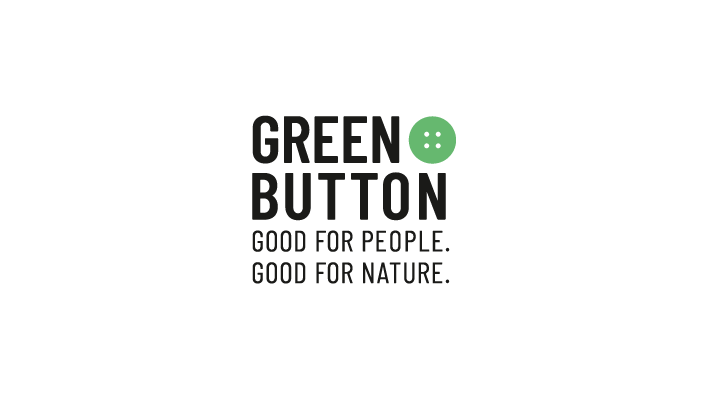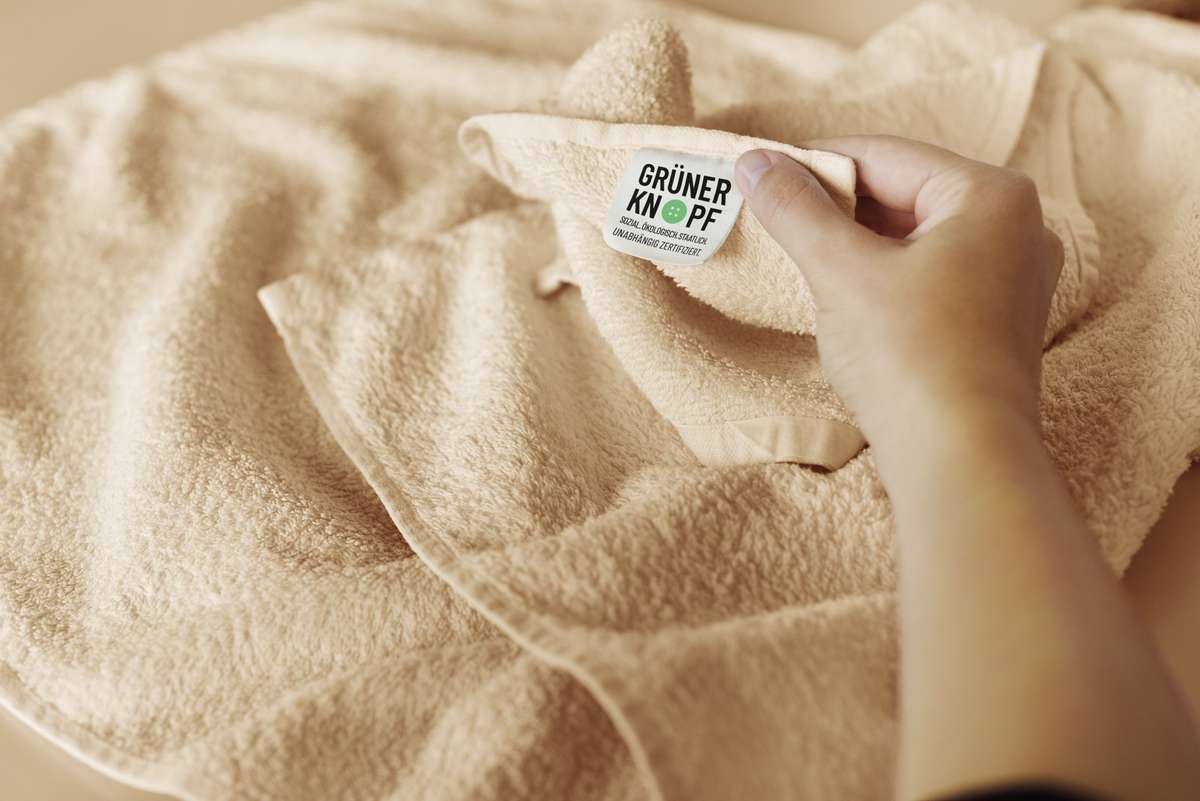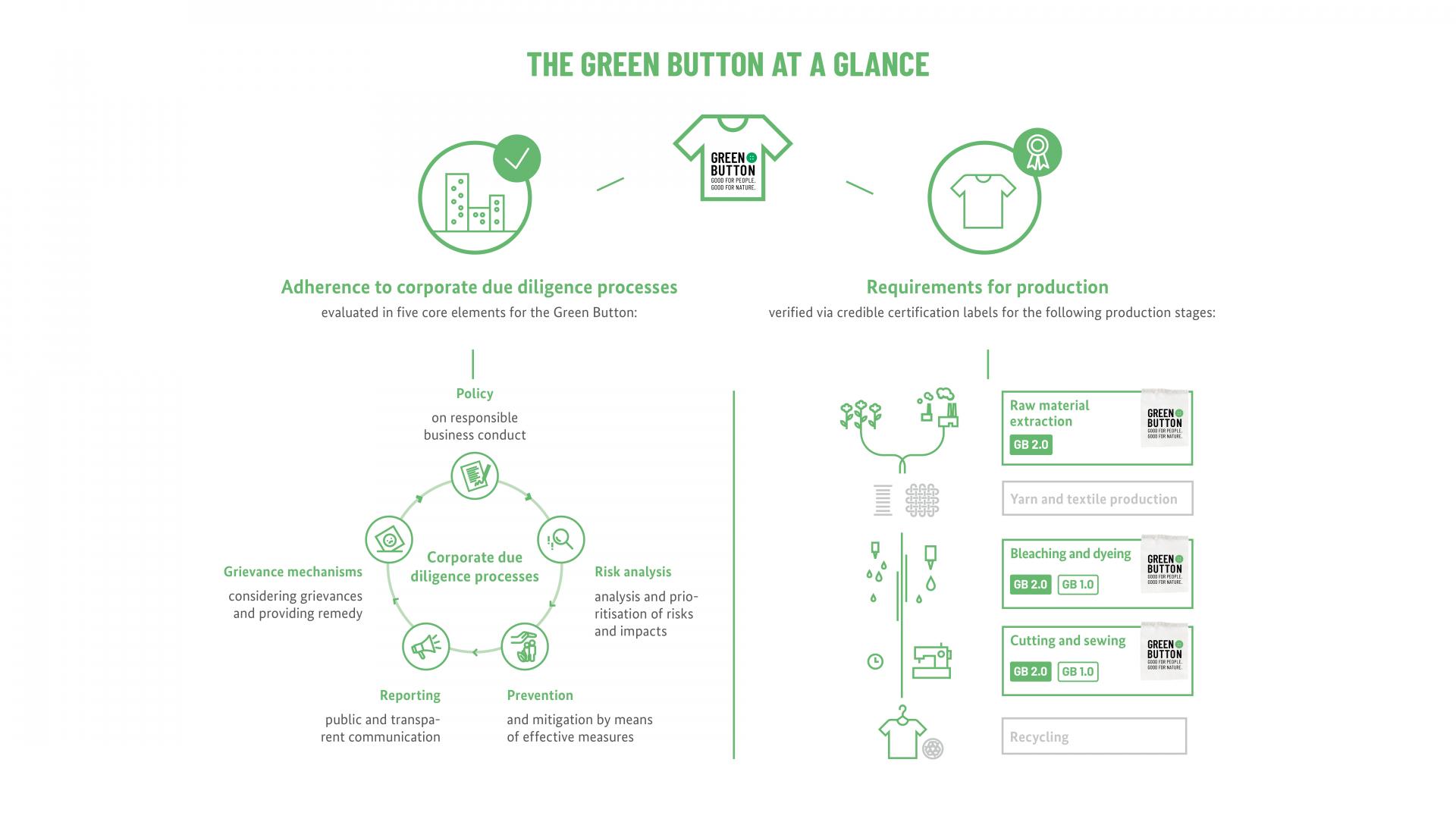Government-run textile certification label The Green Button
The Green Button makes it easier to identify sustainable textiles – from T-shirts to backpacks to work clothing to bath towels.
If a product bears the Green Button, it means that it meets stringent social and environmental requirements and is made by a company that takes responsibility for its textile supply chain.
Which companies are carrying Green Button items in their product range?
More than 60 companies have items with the Green Button label in their range of products (as at August 2025). Among them are sports and leisure brands, pioneering sustainable companies, family businesses and major retailers. They include companies based both in Germany and abroad.
A full list of the companies can be found here (External link).
How well known is the label?
A representative survey of 1,000 people carried out by the market research institute GfK in 2022 concluded that the Green Button is set to become a success story: 44 per cent of those surveyed were aware of the textile label, with that figure rising to 52 per cent among those with a special interest in fashion.
The latest study by the German sustainability platform Utopia “Lost im Label-Dschungel” (Lost in the label jungle) surveyed 3,000 users with an interest in sustainability for the second time (previous survey: 2019). This survey also revealed a high level of recognition for the Green Button: a multiple-choice question (i.e. aided awareness) showed recognition levels of 70 per cent. In the case of open questions (i.e. unaided awareness), the Green Button was the textile label mentioned most frequently, by 32 per cent of those surveyed. Trust in the Green Button label was also high at 67 per cent.
Another key result of the survey was that the recognisability of sustainable products is the biggest driver of responsible consumption. Of those surveyed, 85 per cent were guided by labels when purchasing sustainable products, and assessed a label’s credibility based on who it was awarded by. Government scheme owners are very well regarded, with 72 per cent considering them trustworthy.
Sales
The Green Button has already become well established in the market in the few years that it has been in existence – despite various crises such as COVID-19. The label’s recognition is reflected in the sales figures: from its initial launch to mid-2022, more than 260 million items carrying the Green Button label were sold.
Textile processing companies and clothing retailers have an obligation to ensure that human rights standards are met during production. This basic concept has been an important development in recent years. (...) The system behind the Green Button offers an opportunity to make significant progress in the implementation of environmental and social standards in global supply chains.
What does the Green Button stand for?
- Socially sound – benefitting people | The working and social conditions in textile production are improved.
- Ecologically sound – benefitting the environment | The environment is protected during the textile manufacturing process.
- Government-run – establishing trust | The criteria and conditions for the Green Button are set out by the government. This creates clarity and trust – for consumers, companies and those responsible for procurement.
- Independently audited and certified | Independent auditors monitor compliance with the criteria. For this, they need to have formal accreditation from the scheme owner.
What is special about the Green Button?
The government-run Green Button label is only awarded to companies that systematically take responsibility for the supply chains that deliver their raw materials and intermediate products. By doing so, the companies fulfil their corporate due diligence obligations. In addition, they need to be able to credibly demonstrate that they have manufactured the product in question in a sustainable way.
This combination of requirements for the companies themselves and for their production processes and products is unique in the market.
The Green Button at a glance
Product audits
All textile products marked with the Green Button have to meet strict requirements for their production processes. Certification labels recognised by the Green Button can be used to determine this. These are labels that meet the German government’s credibility criteria and for which the scheme owners have set defined social and environmental standards for the production process. These include, for instance:
- a ban on the use of dangerous chemicals and pesticides
- a limit on working hours and fixed employment contracts
- a ban on discrimination and harassment
- workplace safety regulations
The requirements currently apply to the production stages for cutting and sewing, and bleaching and dyeing. The latest version of the standard, Green Button 2.0, also sets requirements for the fibres and materials used.
Company audits
An item of clothing goes through many different production stages before it ends up in our wardrobe. As a result, textile supply chains are not only long, but also span a web of different locations around the world. Green Button-certified companies take responsibility for their activities and meet their environmental and human rights due diligence obligations. The questions addressed during company audits include:
- Does the company analyse the risks to people and the environment in its supply chain?
- Does it take effective measures to avert such risks and eliminate any shortcomings?
- Do garment workers have access to grievance mechanisms where they work and live?
The requirements have been further developed in the latest iteration of the standard, Green Button 2.0. They include:
- taking important steps towards achieving living wages
- gradually expanding risk analysis to cover the entire supply chain
- embedding due diligence processes more strongly within the company
- increasing the involvement of local people.
Sustainable procurement
More and more hotels, hospitals, associations and fire services are paying attention to sustainability when procuring their textile products. The Green Button has become a reference label for sustainable procurement. Some organisations have already made the shift:
- Around 43,000 Deutsche Bahn employees in public-facing roles now wear certified outerwear.
- Some 8,000 medical staff at the Charité in Berlin – one of the biggest teaching hospitals in Europe – will be provided with sustainable garments in future. This will apply to around 85,000 items of clothing, and to the roughly 100,000 textile items used in surgery. Bedding, towels and other textile products will follow.
- Germany’s two major faith-based social service agencies, the Protestant Diakonie Deutschland and the Roman Catholic Deutscher Caritasverband, are opting for sustainable textiles, too. Together, they constitute Germany’s largest buyers of textiles outside of the public sector. They have as many as 2.2 million beds in their 56,000 care facilities, for which they need huge quantities of bedding. Deutscher Caritasverband is introducing its first work clothing bearing the Green Button label at three initial pilot facilities.
- Football fans can now kit themselves out with sustainable merchandise: many of the football clubs in the German Bundesliga offer products certified with the Green Button.
As at: 25/04/2023



